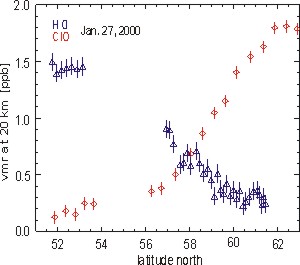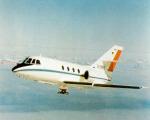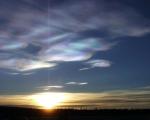| EUPLEX |
EUPLEX (EUropean Polar stratospheric cloud and Lee-wave EXperiment) is an airborne campaign scheduled to take part from mid-January to mid-February 2003 in Kiruna (Northern Sweden). It is part of the European VINTERSOL programme (see e. g. European Ozone Research Coordination Unit). It will deploy two aircraft, the MM5 Geophysica and the DLR Falcon, which will be used in a coordinated manner. The Geophysica will be equipped with numerous instruments, most of which measuring in-situ. The Falcon will deploy the complete SCIAMACHY validation payload, consisting of the OLEX lidar system, the AMAXDOAS instrument, and ASUR. The objectives of EUPLEX are to critically test current hypotheses for the three key processes of Arctic stratospheric ozone depletion chemistry. ASUR's measurement capabilities allow to provide information on all three processes.
PSC formation and properties in Lee-wave and synoptic scale PSCs. ASUR is capable of providing vertical profiles of HNO3, which is a key constituent of PSCs. From the observation of the uptake of HNO3 into a PSC during a PSC underflight conclusions about the composition of a PSC [von König et al., 2002] and possibly its formation and development can be drawn. Measurements of background HNO3 provide a valuable information that can be used as an input parameter for PSC modelling, e. g. modelling of the recently discovered "NAT-rocks" [Fahey et al., 2001, Carslaw et al., 2002]. Further the ASUR HNO3 measurements can be used to determine denitrification [Kleinböhl et al., 2002].
Halogen activation on PSCs. ASUR measures vertical profiles of the halogen compounds HCl and ClO, which play the dominant role for ozone loss in the polar winter. The high horizontal resolution of the ASUR measurements (~15 km for HCl, ~40 km for ClO) makes them suitable for studies dealing with large variations on small horizontal scales, e. g. chlorine activation in the presence of lee-wave induces PSCs, or in close proximity to the vortex edge (see image). ASUR's HCl measuremens will be particularly valuable for EUPLEX as no in-situ measurements of HCl will be performed on board the Geophysica.
Chemical ozone loss. ASUR is capable of measuring ozone and N2O in a large altitude range. As N2O can be used as a dynamical tracer in the polar stratosphere, the chemical loss of ozone can be seperated from dynamical variations and therefore determined by ASUR measurements. This has been shown during the SOLVE/THESEO-2000 mission in winter 1999/2000 [Bremer et al., 2002].
Further mission objectives will be the performance of measurements for satellite validation purposes, e. g. for the MIPAS-instrument on board ENVISAT, the radiometer of the ODIN satellite, and NASA's SAGE III. The latter validation effort will be coordinated with the SOLVE-2 campaign of NASA's DC-8 research aircraft, which will be also operated from Kiruna in January/February 2003.

References:
The "stratosphere-mesosphere intercomparison of ozone profiles" is a collaboration between ASUR and the Arctic Lidar Observatory for Middle Atmosphere Research (ALOMAR), Norway, that was made possible by the "Access to Research Infrastructure" (ARI) programme by the European Union.
 |
 |
|
|
|
|
Author: 27/09/2002
Armin Kleinböhl
Designer: 08/04/2002
Tianxun Ba
Last update: 29/11/2002 by
Armin Kleinböhl